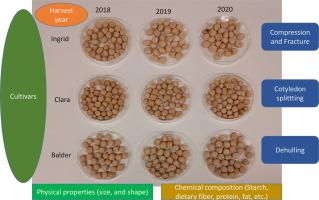瑞典豌豆品种的机械特性
IF 8.2
Q1 FOOD SCIENCE & TECHNOLOGY
引用次数: 0
摘要
像瑞典豌豆这样的豆类的机械或质地属性对磨粉过程的发展很重要,比如去皮、分裂子叶或制作面粉。本研究旨在更好地了解不同年份(2018年、2019年和2020年)收获的瑞典豌豆品种(Ingrid、Clara和Balder)的压缩和断裂行为、子叶分裂和脱壳现象与化学成分剖面和物理属性的关系。瑞典豌豆的物理性状与特定品种和环境生长条件密切相关。豌豆样品中大部分化学成分(淀粉、膳食纤维)在不同品种和收获年份间无显著差异。只有蛋白质含量(16.9 ~ 19.6%)在不同品种和收获年份间存在显著差异。采收年份和品种类型的环境条件对断裂和脱壳相关参数没有显著影响。子叶分裂现象与不同大小形状相关参数和淀粉含量有显著关系(47.6% ~ 50.0%)。本研究运用断裂力学原理对瑞典豌豆品种的力学属性进行了分类。我们的工作将有助于植物育种家找到科学的基因定位,为未来作物的发展提供更好的碾磨效率和脉冲碾磨工业,采用豌豆品种特异性的脱皮和碾磨工艺开发。本文章由计算机程序翻译,如有差异,请以英文原文为准。

Mechanical attributes of Swedish pea cultivars
Mechanical or textural attributes of pulses like Swedish pea are important for milling process development like dehulling, splitting of cotyledons or making flour. This research is an attempt to gain better understanding of the compression and fracture behavior, cotyledon splitting and dehulling phenomena of Swedish pea cultivars (Ingrid, Clara and Balder) harvested from different years (2018, 2019 and 2020) in relation to chemical compositional profile and physical attributes. Physical attributes of Swedish pea were highly associated with specific cultivar types and environmental growth conditions. Majority of the chemical components (starch, dietary fibers) in pea samples were not significantly different between the cultivars or harvest years. Only protein content (16.9–19.6 % range) differed significantly between the cultivars and harvest years. Environmental conditions of the harvest year or cultivar types could not cast any significant difference in fracture or dehulling related parameters. Cotyledon splitting phenomena were significantly linked to different size and shape related parameters and starch content (47.6–50.0 % range). This study applies fracture mechanics principles to classify Swedish pea cultivars in terms of different mechanical attributes. Our work will help plant breeders to find scientific insight for gene targeting for future crop development with better milling efficiency and pulse milling industry to adopt pea cultivar specific dehulling and milling process development.
求助全文
通过发布文献求助,成功后即可免费获取论文全文。
去求助
来源期刊

Future Foods
Agricultural and Biological Sciences-Food Science
CiteScore
8.60
自引率
0.00%
发文量
97
审稿时长
15 weeks
期刊介绍:
Future Foods is a specialized journal that is dedicated to tackling the challenges posed by climate change and the need for sustainability in the realm of food production. The journal recognizes the imperative to transform current food manufacturing and consumption practices to meet the dietary needs of a burgeoning global population while simultaneously curbing environmental degradation.
The mission of Future Foods is to disseminate research that aligns with the goal of fostering the development of innovative technologies and alternative food sources to establish more sustainable food systems. The journal is committed to publishing high-quality, peer-reviewed articles that contribute to the advancement of sustainable food practices.
Abstracting and indexing:
Scopus
Directory of Open Access Journals (DOAJ)
Emerging Sources Citation Index (ESCI)
SCImago Journal Rank (SJR)
SNIP
 求助内容:
求助内容: 应助结果提醒方式:
应助结果提醒方式:


